Updated March 8, 2022 at 1:06 PM ET
Editor's note: This story has been updated to reflect President Biden's announcement of a ban on U.S. imports of Russian oil and gas.
Last week, the head of Russia's central bank, Elvira Nabiullina, walked up to a microphone to the sound of cameras snapping. She had some bad news for her nation.
"The conditions for the Russian economy have altered dramatically," Nabiullina said in Russian. "The new sanctions imposed by foreign states have entailed a considerable increase in the ruble exchange rate and limited the opportunities for Russia to use its gold and foreign currency reserves."
Translation: Facing one of the harshest sanction campaigns against any nation in modern history, Russia is in for a world of hurt.
To save the Russian currency from collapse and to combat inflation, Nabiullina said, the Central Bank of Russia was raising its key interest rate to a staggering 20% — an all-time high. That's also higher than the equivalent interest rate in the U.S. — the Federal Reserve's federal funds rate — has ever been (although the Fed came close in the early 1980s, when Fed Chair Paul Volcker, aiming to stop runaway inflation, increased the rate to 19% and caused a deep recession).
As Nabiullina dropped her bombshell — which, together with the effects of foreign sanctions, is expected to usher in a calamitous recession for Russia — she was wearing all black. You could say like the Grim Reaper. But her black turtleneck was also a bit reminiscent of Steve Jobs and Elizabeth Holmes. We normally wouldn't remark on what a policymaker was wearing. However, Nabiullina has explicitly said that what she wears at news conferences tends to have symbolic meaning.

Accessories send a message
Over the past couple of years, Nabiullina has taken to wearing brooches to symbolize the mood of the Russian economy and the actions of the Bank of Russia. "I've been wearing brooches for a long time," Nabiullina told the news station RTVI in December 2020. But in 2020, she said, she began using brooches to signal messages. "I put something into each symbol, but I'm not going to explain."
In February 2020, for example, Nabiullina wore a brooch that looked like a stork. Months before, a journalist had asked her what kind of bird she considered herself to be. Was she a hawk? Meaning, she favors the tight monetary policy of higher interest rates to combat inflation. Or was she a dove? Meaning, she favors lower interest rates and is more willing to see inflation rise. Nabiullina said she wasn't sure if she was a bird at all. However, at that February meeting, when she announced that the bank was slightly cutting interest rates, she identified herself with a stork — which some suggested was symbolic of a new life for the Russian central bank and economy.
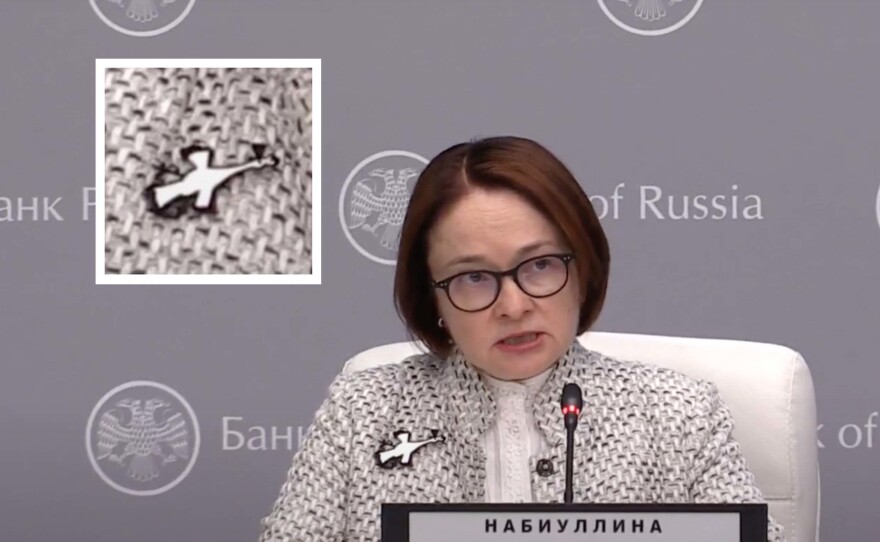
In March 2020, at a news conference where she announced the central bank was taking measures to support the nation's financial sector amid the coronavirus pandemic, Nabiullina wore a brooch showing a Russian roly-poly doll, or nevаlyashka. These dolls have round bottoms and are designed so that when you push them over, they roll back upright. Observers suggested it was meant to symbolize Russia's economy coming back after getting knocked over by the pandemic.
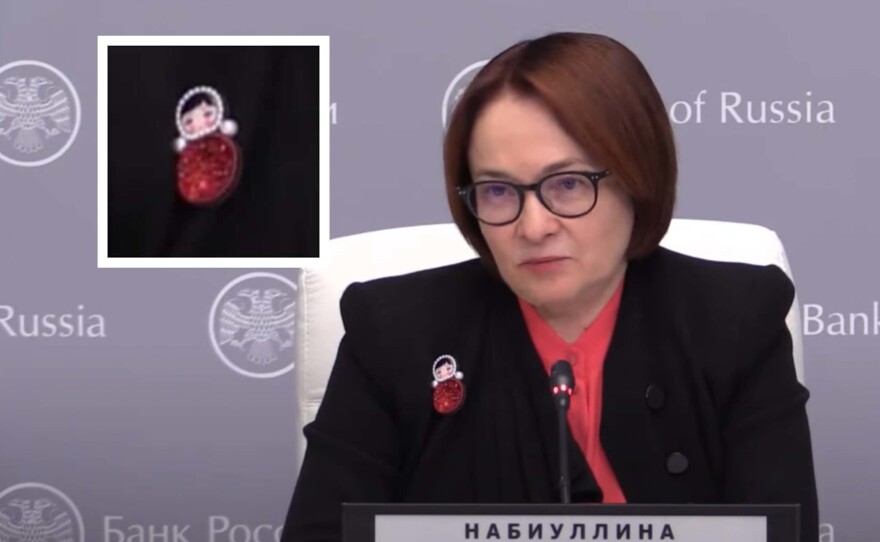
In April 2020, with the pandemic in full swing, Nabiullina wore a brooch of a house. "Please, stay at home," she said at the end of her news conference.

In June 2020, the Bank of Russia cut interest rates by a full percentage point in an effort to juice the economy. Naturally, she wore a dove pin.
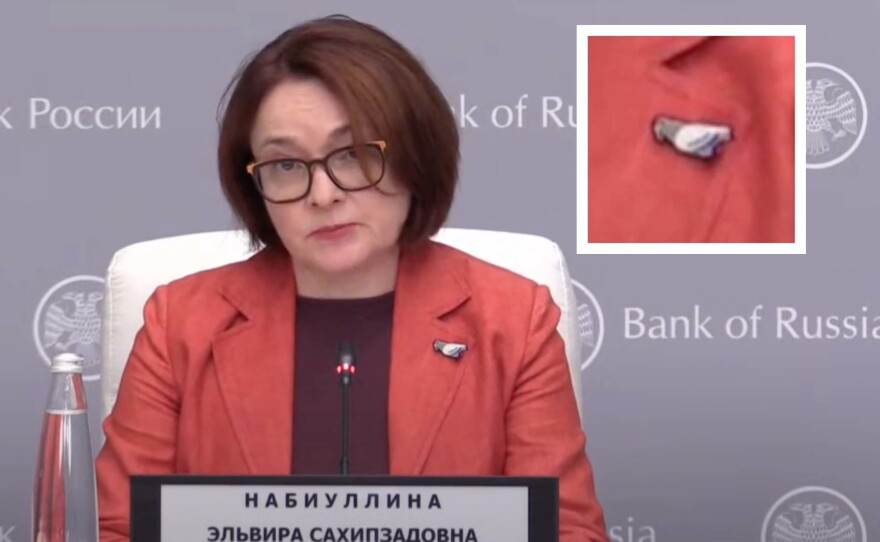
In July 2020, Nabiullina wore a brooch with the letter V. Observers widely interpreted it as symbolizing the central bank's hopes for a rapid, V-shaped recovery.
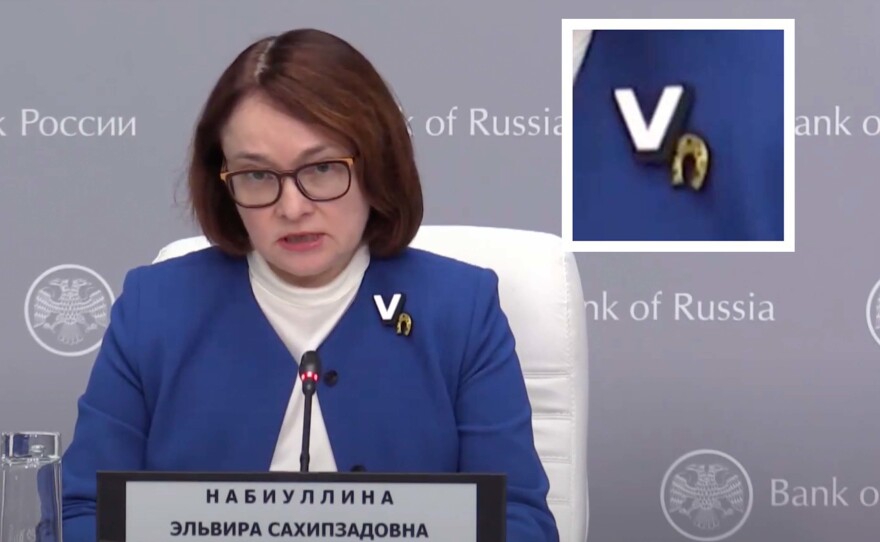
In October 2020, Nabiullina wore a brooch showing waves. Some observers suggested it was because another wave of the coronavirus was surging. Others thought it meant she believed there was about to be geopolitical turbulence caused by the anticipated election of Joe Biden. She later denied the latter theory.
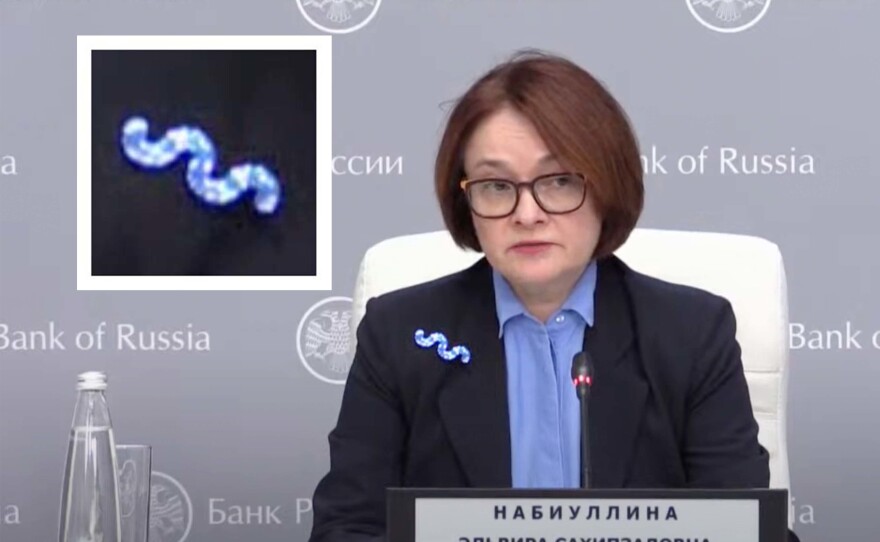
In March 2021, the Bank of Russia raised interest rates in an effort to slow inflation. Naturally, she wore a hawk pin.
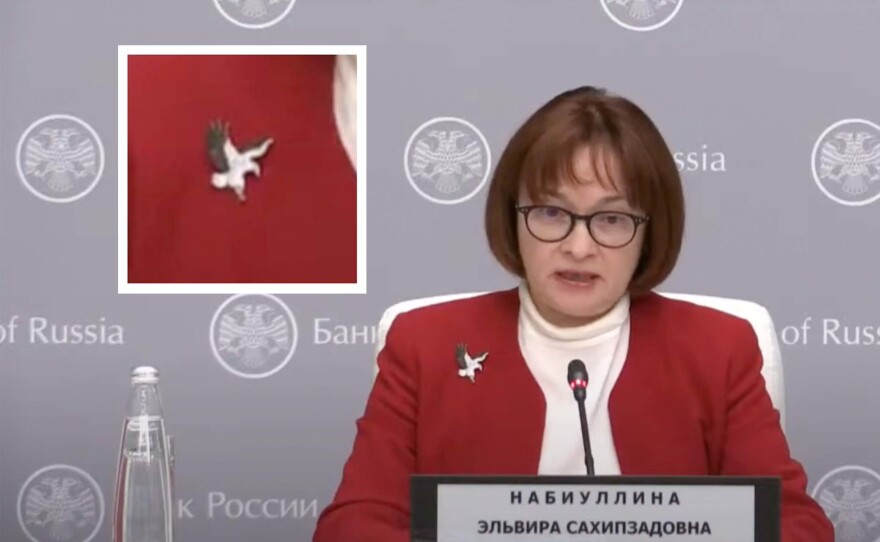
In December 2021, Nabiullina wore a festive nutcracker pin. In that news conference, she announced that the Bank of Russia was raising interest rates for the seventh time in a row. Perhaps the pin was symbolic of the central bank's efforts to crack the hard nut of inflation.
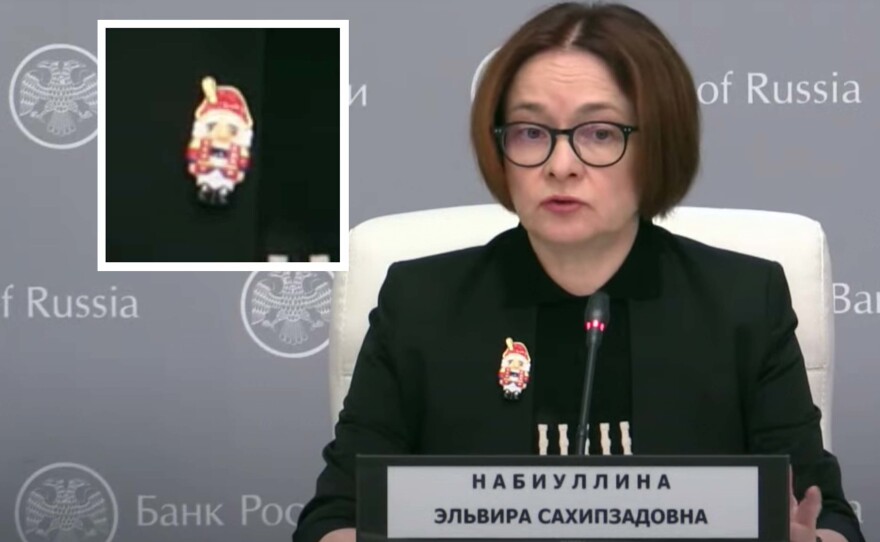
The meaning of all black, no pin
Over the last couple of weeks, in response to Russia's invasion of Ukraine, the U.S., the European Union and their allies have launched an economic war against Russia. It has probably been the most stressful period for Russian economic policymakers in a generation. In her first public appearance during the war, Nabiullina chose to wear all black with no brooch. Maybe it's because she didn't think it was a time to have fun. Or maybe her all-black outfit with no pin conveyed something dark about the Russian economy. You know, like she was attending a funeral or a death metal concert or something. We don't know.
We do know that the wide-ranging sanctions imposed by the West seem to be working. Western allies are disrupting Russian flights with sanctions and no-fly zones, damaging the Russian aviation industry and making it hard for Russian business people to travel. They're seizing the assets — like superyachts — of Russian oligarchs. They've frozen hundreds of billions of dollars' worth of the central bank's foreign reserves, which are critical to Russia's ability to stabilize its currency and circumvent sanctions. They are preventing Russian banks from using the SWIFT communication system, which is essential for financial institutions to transfer money internationally. They've been pushing Russian corporations to the brink of collapse. They've driven the value of the Russian ruble to record lows. As a result, Russians have been lining up at ATMs and desperately trying to convert their rubles into stable assets, like hard goods or other currencies.
Oxford Economics, an analysis company, estimates the Russian economy could shrink by as much as 7% as a result of the sanctions. For comparison, that's almost double the amount the U.S. economy contracted during the Great Recession. Expect business failures, skyrocketing unemployment and countless miseries for the Russian people.
[Editor's note: This is an excerpt of Planet Money's newsletter. You can sign up here.]
After initially resisting placing sanctions on Russia's lucrative energy sector, the Biden administration on Tuesday morning announced it was placing a ban on U.S. imports of Russian oil and gas. "The United States is targeting the main artery of Russia's economy," President Biden said. "That means Russian oil will no longer be acceptable at U.S. ports, and the American people will deal another powerful blow to Putin's war machine." Global oil prices, as a result, are expected to climb.
In addition to jacking up interest rates to historic levels, the Bank of Russia and the Russian Finance Ministry made bold moves to stabilize the ruble. They put the squeeze on Russian exporters — namely, Russian energy companies — ordering them to exchange 80% of their foreign currency reserves for rubles. The Russian government has also resorted to capital controls, preventing Russians from sending money to other countries.
The past and future of pins
Nabiullina isn't the first policymaker to use brooches to give hints about what they're thinking. Former U.S. Secretary of State Madeleine Albright famously used pins in the same way.
"Shortly after becoming a diplomat, Madeleine Albright discovered the power of jewelry to convey foreign policy messages," the U.S. State Department says on an official website, Read My Pins: The Madeleine Albright Collection. "Before long, she began selecting appropriate pins to wear to particular meetings visually expressing her messages, including those of high hopes, determination, impatience, warnings or warm feelings."
We have no idea which brooches Nabiullina will be wearing in the coming months. But we can hope one will be a peace sign, or a white flag of surrender.
Did you enjoy this newsletter segment? Well, it looks even better in your inbox! You can sign up here.
Copyright 2022 NPR. To see more, visit https://www.npr.org. 9(MDAzMjM2NDYzMDEyMzc1Njk5NjAxNzY3OQ001))







